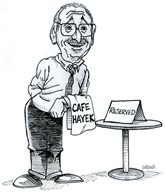That is the real problem underlying all of this. Congress has delegated virtually its entire legislative power to the executive branch, over the course of the last century and a half. Congress spent a century encouraging presidents to act as the nation’s lawmaker-in-chief, and now presidents routinely make executive-branch laws affecting thousands or millions of Americans in one fell swoop. And when those instant edicts spur instant litigation, federal trial judges are left to decide whether a ruling against the administration’s seemingly unlawful action should bind the president completely, or only as to the plaintiffs at hand.
This creates problems for government, and judges exacerbate the problem when they make incorrect decisions. But judges did not create the problem. Presidents created this problem through unrestrained assertions of power. More fundamentally, Congress created this problem by largely freeing presidents from legislative restraints.
Politicians have a habit of channeling their constituents’ fandom into taxpayer-funded goodies — just look at the current talks over a new football stadium in D.C. The bipartisanship of motorsports favors extends beyond Young and Warner’s bill. North Carolina, under Democratic Gov. Roy Cooper, used money from Joe Biden’s American Rescue Plan Act to help refurbish North Wilkesboro Speedway. A law supposedly about covid recovery was used to fund improvements to a track that had been vacant since 1996, for the use of NASCAR, which has plenty of money of its own.
Some reasons to oppose this latest racing bill are specific to the sport. Most racetracks are small operations that don’t generate extraordinary amounts of economic activity, and the large tracks that do host premier racing series only create significant economic impact one or two weekends per year. Eleven out of 12 months are not “the month of May,” and aside from one weekend hosting NASCAR, Indianapolis Motor Speedway is little more than a museum, gift shop and landmark for most of the year.
The SEVIS terminations “reflect an instinct that has become prevalent in our society to effectuate change: move fast and break things,” writes U.S. District Judge Jeffrey White, a George W. Bush appointee who is considering several lawsuits by foreign students in the Northern District of California. “That instinct must be checked when it conflicts with established principles of law.”
White’s preliminary injunction bars the government from “arresting and incarcerating any of the named Plaintiffs in these cases and similarly situated individuals nationwide pending resolution of these proceedings.” The injunction also says the government may not transfer any of those individuals “outside the jurisdiction of their residence,” impose “any adverse legal effect” based on the SEVIS terminations, or “revers[e] the reinstatement” of the records.
Explaining the rationale for a nationwide injunction, White says the plaintiffs “have met their burden to show a likelihood of irreparable harm.” He “sees no rational distinction between the harms inflicted on the [named plaintiffs] and the harms inflicted on similarly situated individuals across the United States.” He notes that “these cases and the litigation around the United States” stem from “a uniform policy that uniformly wreaked havoc not only on the lives of Plaintiffs here but on similarly situated F-1 nonimmigrants across the United States and continues do so.”
David Brooks doesn’t get every last detail in this piece correct, but most of it is spot-on and relevant. Three slices:
There’s a story haunting American politics. It’s a story told by right-wing populists like Donald Trump and JD Vance and left-wing populists like Bernie Sanders. The story goes something like this: There once was an America, in the 1950s and 1960s, that made stuff. People could go off to work in factories and earn a decent middle-class wage. Then came globalization and the era of market-worshiping neoliberalism. During the 1990s and early 2000s, America signed free trade deals like NAFTA. China entered the World Trade Organization in 2001. Jobs were shipped overseas. Factories shut down. The rich prospered while members of the working class got pummeled and ended up voting for Trump.
The problem with this story is that it’s 75 percent bonkers — historically inaccurate on nearly every front.
In the first place, there never was a market-worshiping era of pure globalization. As the economics writer Noah Smith has noted, top marginal tax rates were significantly higher in 2016 than in 1992. Federal spending on social programs went up, not down. Government policy became more progressive (favoring those down the income scale), not less. Much of the economy grew more regulated, not less. U.S. tariff rates were basically stagnant.
…..
The third problem with the story is that it exaggerates how much foreign competition has hurt American workers. Yes, the China shock was real. In a landmark 2013 paper, David Autor, David Dorn and Gordon Hanson found that America lost an average of 90,000 jobs per year between 1990 and 2007 because of imports from China. But put that in perspective. According to [Michael] Strain, five million Americans currently separate from their employers per month. Plus, in a 2019 paper, Robert C. Feenstra, Hong Ma and Yuan Xu found that the China shock job losses were largely offset by job gains, owing to higher exports.
American manufacturing jobs have declined mostly for the same reason American farming jobs have declined. We’re more productive, able to make more stuff with fewer workers. That’s not primarily a story about neoliberalism or globalization; it’s progress.
If manufacturing jobs are moving, it’s often from the American Midwest to the American South. As Gary Winslett pointed out in The Washington Post, in 1970 the Rust Belt was responsible for nearly half of U.S. manufacturing exports, and the South was responsible for only a quarter. Today the South is responsible for half of U.S. manufacturing exports, and the Rust Belt is responsible for only a quarter. The Southern states lured manufacturing investments with right-to-work laws, cheap energy, affordable housing, low-cost land and fast permitting. Now the No. 1 auto-exporting state is Alabama. It’s really hard to argue that America’s problem is a lack of manufacturing jobs when nearly half a million manufacturing job openings are unfilled.
The so-called era of neoliberal globalism has not produced the American carnage that Trump imagines. According to the political scientist Yascha Mounk, in the 1990s and early 2000s, America and Europe were similarly affluent. Today the American economy has left the other rich economies in the dust. American G.D.P. per capita is around $83,000, while Germany’s is around $54,000, France’s is around $45,000, and Italy’s is around $39,000.
As The Economist recently noted, “On a per person basis, American economic output is now about 40 percent higher than in Western Europe and Canada and 60 percent higher than in Japan — roughly twice as large as the gaps between them in 1990. Average wages in America’s poorest state, Mississippi, are higher than the averages in Britain, Canada and Germany.”
…..
These statistics are not abstractions that don’t touch regular people’s lives. According to the Organization for Economic Cooperation and Development, in 2023 American households had $63,000 in disposable income, while French households had only $35,000, and British households had only $36,000. The average home size in the United States is around 2,000 square feet. The average British home size is less than 1,000 square feet.



